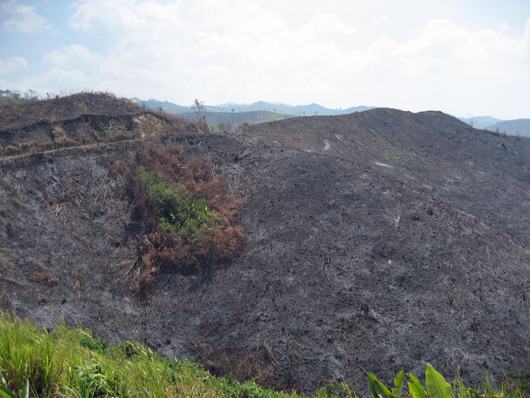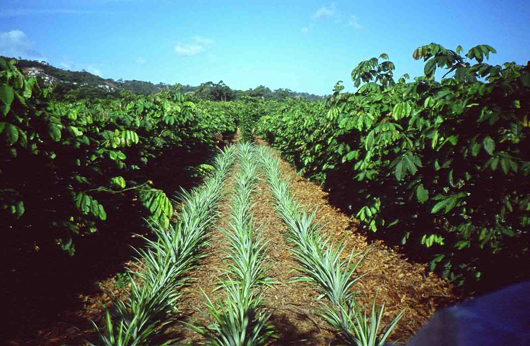Honduras: "Up in Smoke" UK premiere
27.09.11
A very important film premieres on UK television tonight that could help transform tropical agriculture. "Up in Smoke" follows the exploits of Mike Hands, a scientist from Cornwall in the UK, who has been developing an innovative agroforestry technique called alley-cropping in equatorial rainforests for 25 years.
"Up in Smoke", directed by Adam Wakeling, airs tonight (September 27) at 10pm on More 4. Filmed over four years in Honduras and in the UK this fascinating film follows Hands' battles as he tries to win over Honduran farmers with the benefits of the Inga tree while struggling to put the issue of slash and burn agriculture at the top of global climate meetings.
The UN estimates between 300 and 500 million people around the world are dependent on slash and burn agriculture: a technique that devastates rainforest, degrades the land, while quickly diminishing the essential nutrients in the soil on which the farmers depend. Hands realised a long time ago this technique was unsustainable so began to develop a technique that could make less land go further.
I've spoken to Hands many times and his enthusiasm is infectious, but he is also realistic that this is a huge political and social battle.
A “slowly enacted catastrophe” is being played out across the tropics, says Hands who thinks he holds at least some of the answers to this catastrophe in 25 years’ worth of data he’s collected in Costa Rica and Honduras.

A mountain slope in Honduras recently burnt for agriculture
‘Slash and burn’ is a familiar phrase to everyone, and perhaps conjures up images of small areas of forests being cleared for agriculture. But to Hands it means a great deal more. It represents the product of nearly a lifetime’s work that opened up to him while working as a landscape surveyor in Africa.
Working in Ghana and Ethiopia Hands couldn’t help but notice the effect of burning on the landscapes he was coming to love. “I’ve always loved nature, it’s never left me, but it took a midlife crisis – you might call it – to want to do it as my job." It was a somewhat chance encounter with the “great Cambridge zoologist” E. Barton Worthington in Ethiopia that gave Hands the necessary impetus to change his career.
Worthington was about 80 at the time and Hands acted as his eyes as he surveyed the local wildlife. They shared a natural affinity as they counted the herds of Grévy's zebra and antelope and it was here they began to talk about the impact of slash and burn farming. In an early conversation Worthington said, “that it (slash and burn) adds fertiliser to the soil”, “which of course it does in a sense” added Hands, but he soon began to realise this benefit was very temporary. Hands saw the soils were quickly impoverished by the burning regimes and the flora of the landscape became noticeably changed as it became dominated by grasses.
Slash and burn isn’t a new phenomenon. It’s merely an evolution and intensification of an older, more sustainable, form of agriculture known as shifting cultivation where farmers would clear areas of forest, grow crops on it for a few years, and then move on. The difference with the modern cycle of slash and burn farmers is that population pressures have virtually eliminated the ability to move onto new lands. Land can only be left for a handful of years before they need to be burnt again. Nutrients are lost until the land can no longer be farmed, forcing the farmers further up the slopes, deeper and deeper into the rainforest.
Hands tells me “there are more than 300 million people involved in slash and burn farming around the world” making this a truly pan tropical issue. He says “if this was like a tsunami or an earthquake it would be in the press every day.” In a sense this is a greater catastrophe.
To the rescue came the Inga tree and a method Hands has called alley-cropping. This involves growing corridors, or alleys, of Inga and in the spaces in between the cash crops can be grown. Inga, being leguminous, fixes nitrogen and the crops are mulched by the branches of the trees. This process holds the soil together and the nutrients in the ground.

Pineapples growing in an Inga alley surrounded by mulch from the trees
Hands has been told that an average Honduran small holding is about eight hectares, so his Guama (the local name for Inga) model is based around this land area. In the old technique all eight hectares would be destroyed and used for growing cash crops, but in the Guama model only three hectares are used for crops leaving five to remain as wildlife rich rainforest.
Hands hopes the farmers will share their stories of the difference Inga
is making to their lives
Tune in tonight to More 4 to hear the stories of the people involved in this fascinating journey.
Related links:
4Talks where Mike Hands talks to the Guardian's John Vidal and Adam Wakeling